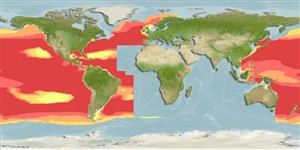Preferred temperature (Ref.
123201): 4.8 - 13.6, mean 7.9 °C (based on 1166 cells).
Phylogenetic diversity index (Ref.
82804): PD
50 = 0.5176 [Uniqueness, from 0.5 = low to 2.0 = high].
Bayesian length-weight: a=0.01122 (0.00514 - 0.02450), b=3.04 (2.87 - 3.21), in cm total length, based on all LWR estimates for this body shape (Ref.
93245).
Trophic level (Ref.
69278): 3.3 ±0.4 se; based on size and trophs of closest relatives
Generation time: 1.3 ( na - na) years. Estimated as median ln(3)/K based on 1
growth studies.
Resilienza (Ref.
120179): Medio, tempo minimo di raddoppiamento della popolazione 1.4 - 4.4 anni (K=0.8, Fec assumed < 1000).
Fishing Vulnerability (Ref.
59153): Low vulnerability (16 of 100).
Nutrients (Ref.
124155): Calcium = 122 [30, 575] mg/100g; Iron = 1.45 [0.39, 6.25] mg/100g; Protein = 4.03 [0.12, 8.02] %; Omega3 = 0.357 [0.113, 1.176] g/100g; Selenium = 20 [4, 91] μg/100g; VitaminA = 80.5 [10.0, 619.6] μg/100g; Zinc = 1.35 [0.56, 3.51] mg/100g (wet weight);
